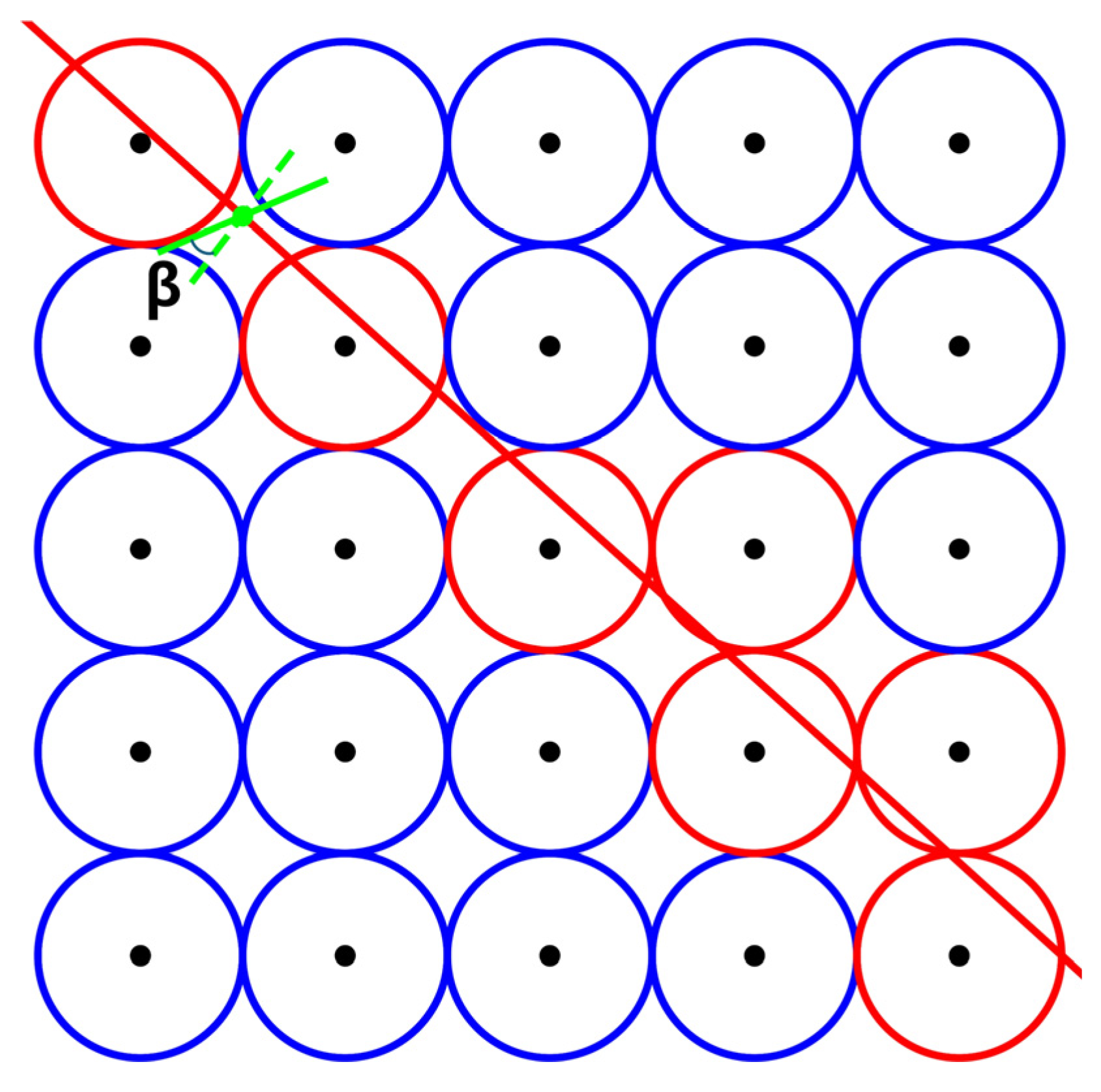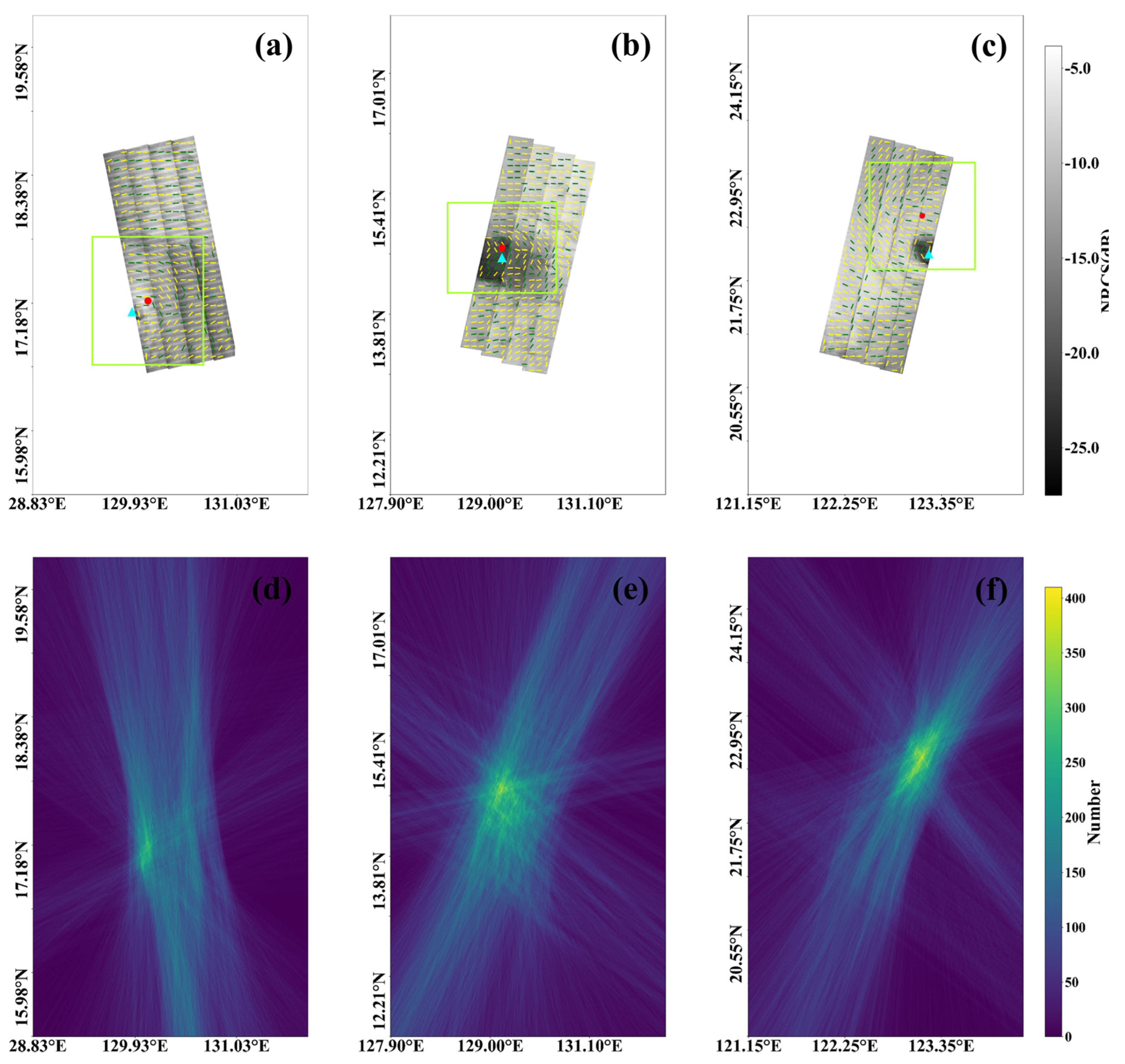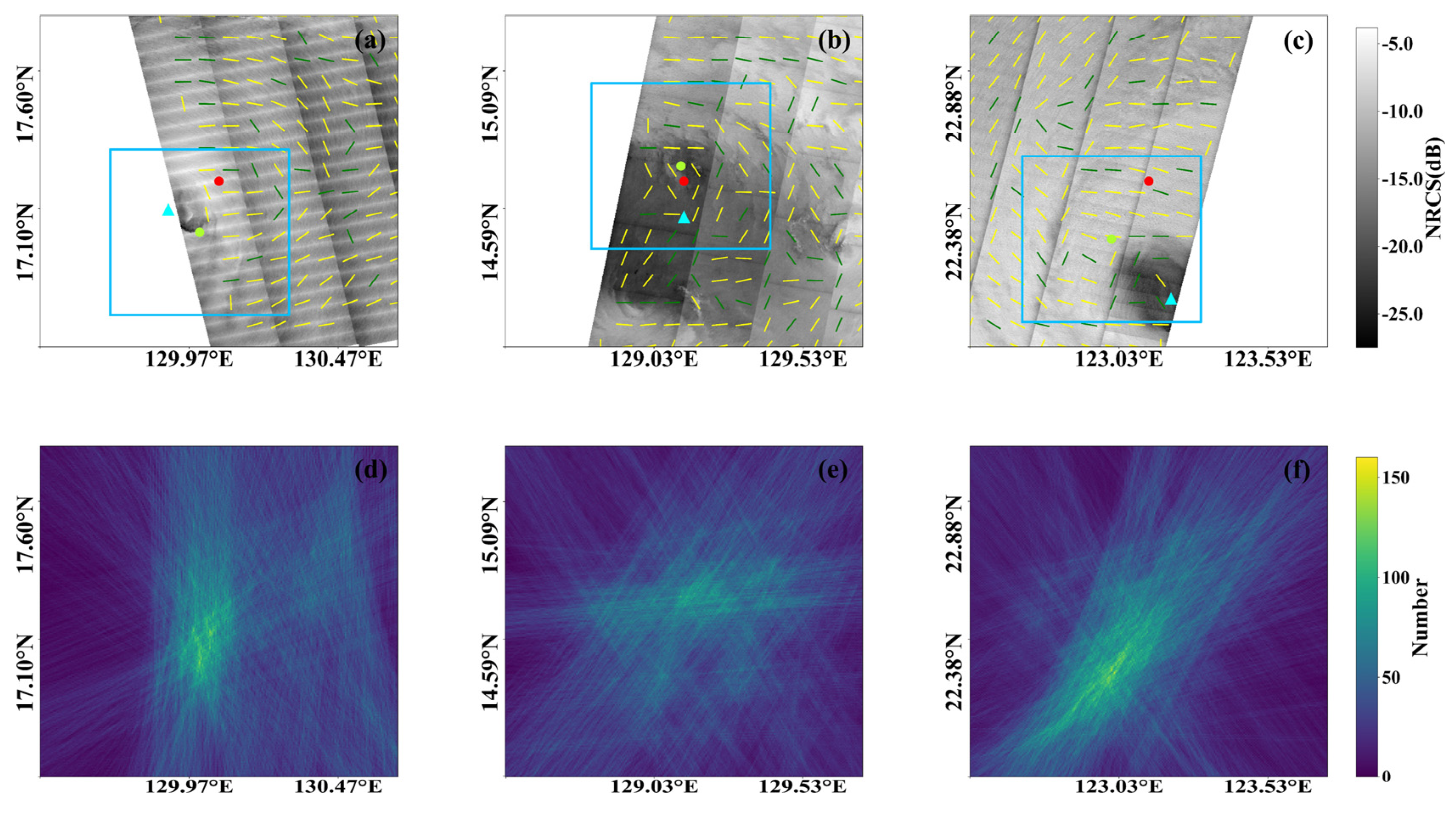Automatic Estimation of Tropical Cyclone Centers from Wide-Swath Synthetic-Aperture Radar Images of Miniaturized Satellites
Abstract
:1. Introduction
2. Miniaturized SAR Images
3. The Procedure of TC Center Estimation
3.1. Stage 1: Coarse Estimation
- (1)
- Determining SSWD points and candidate points: Given that the TC center might fall outside the SAR image’s coverage, a candidate area larger than the SAR image coverage is defined. Initially, the SAR image’s width and height are denoted as ΔLon and ΔLat, respectively. A grid of SSWD points is then created using an interval of m1, resulting in a grid size of . Subsequently, a candidate area centered on the SAR image’s center is defined with a width of 2ΔLon and a height of 2ΔLat. A grid of candidate points is generated within this expanded area using an interval of M1, leading to a total grid size of . In this study, both m1 and M1 are set to 0.01°. It is important to note that the SSWDs are retrieved from the image slices centered on SSWD points, and the TC center position is determined from these candidate points;
- (2)
- SSWD retrieval and quality control: SSWD retrieval from SAR images is typically based on wind streak information. The scale of these wind streaks usually ranges from several kilometers to over ten kilometers. Consequently, centered on these points, image slices with dimensions of 1000 × 1000 pixels are extracted from the original SAR image. The SSWDs are then retrieved from these image slices by the improved local gradient (ILG) method [30]. Subsequently, slide a (2A + 1) × (2A + 1) window over the SSWD points and for the SSWD point (i, j), calculatewhere represents the retrieved SSWD. In this stage, A is set to 5, and the SSWD is removed if . The variable S represents the dispersion of the SSWD. A higher S value indicates greater variability in the SSWDs within the window, whereas a lower S value suggests more consistency. Therefore, we set maximum and minimum thresholds of 0.5 and 0.001, respectively, for S to remove outliers;
- (3)
- Estimating the TC center position: A total of 121 compensation angles within [−50°, 10°] were set at an interval of 0.5°. For each compensation angle, the retrieved SSWD is adjusted by adding the compensation angle. Subsequently, the perpendicular lines of these compensated SSWDs are calculated, and the number of these perpendicular lines passing through each candidate point is counted. As illustrated in Figure 2, if the distance from a candidate point to a line is less than M1/2, the line is considered to pass through the candidate point. It should be noted that the rule for determining whether a line passes through a point is different from that in [23].
3.2. Stage 2: Precise Estimation
- (1)
- Determining SSWD points and candidate points: Centered on the coarsely estimated TC center position, a sub-SAR image with a coverage of L1° × L1° is extracted from the original SAR image. At this stage, the coverage of the candidate area is also L1° × L1°. Subsequently, employing intervals of m2 and M2, grids for SSWD points and candidate points are created, resulting in grid sizes of and , respectively. In this stage, L1 is set to 1.2°, m2 to 0.01°, and M2 to 0.005°;
- (2)
- SSWD retrieval and quality control: Centered on these points, image slices with dimensions of 1000 × 1000 pixels are extracted from the sub-SAR image. The SSWDs are then retrieved from these image slices by the ILG method. Subsequently, Equation (1) was used to remove outliers of retrieved SSWDs. In this stage, A is set to 5, and the SSWD is removed if ;
- (3)
- Estimating the TC center position: A total of 121 compensation angles within [−50°, 10°] were set at an interval of 0.5°. For each compensation angle, the retrieved SSWD is adjusted by adding the compensation angle. Subsequently, the perpendicular lines of these compensated SSWDs are obtained, and the number of these perpendicular lines passing through each candidate point is counted.
3.3. Optional Stage: NRCS-Adjusted Estimation
4. Results
5. Discussion
6. Conclusions
Author Contributions
Funding
Institutional Review Board Statement
Informed Consent Statement
Data Availability Statement
Acknowledgments
Conflicts of Interest
References
- Jaiswal, N.; Kishtawal, C.M. Objective detection of center of tropical cyclone in remotely sensed infrared images. IEEE J. Sel. Top. Appl. Earth Obs. Remote Sens. 2013, 6, 1031–1035. [Google Scholar] [CrossRef]
- Lu, X.; Yu, H.; Yang, X.; Li, X. Estimating tropical cyclone size in the Northwestern Pacific from geostationary satellite infrared images. Remote Sens. 2017, 9, 728. [Google Scholar] [CrossRef]
- Wimmers, A.J.; Velden, C.S. Advancements in objective multisatellite tropical cyclone center fixing. J. Appl. Meteorol. Climatol. 2016, 55, 197–212. [Google Scholar] [CrossRef]
- Zheng, G.; Liu, J.; Yang, J.; Li, X. Automatically Locate Tropical Cyclone Centers Using Top Cloud Motion Data Derived From Geostationary Satellite Images. IEEE Trans. Geosci. Remote Sens. 2019, 57, 10175–10190. [Google Scholar] [CrossRef]
- Yanyan, W.; Han, W.; Hong, C.; Wei-Chi, S. Tropical cyclone center location with digital image process. In Proceedings of the 2001 International Conferences on Info-Tech and Info-Net. Proceedings (Cat. No. 01EX479), Beijing, China, 29 October–1 November 2001; pp. 563–567. [Google Scholar]
- Wong, K.Y.; Yip, C.L.; Li, P.W. Automatic tropical cyclone eye fix using genetic algorithm. Expert Syst. Appl. 2008, 34, 643–656. [Google Scholar] [CrossRef]
- Wei, K.; Jing, Z.-l. Spiral band model optimization by chaos immune evolutionary algorithm for locating tropical cyclones. Atmos. Res. 2010, 97, 266–277. [Google Scholar] [CrossRef]
- Chaurasia, S.; Kishtawal, C.; Pal, P. An objective method of cyclone centre determination from geostationary satellite observations. Int. J. Remote Sens. 2010, 31, 2429–2440. [Google Scholar] [CrossRef]
- Piñeros, M.F.; Ritchie, E.A.; Tyo, J.S. Objective measures of tropical cyclone structure and intensity change from remotely sensed infrared image data. IEEE Trans. Geosci. Remote Sens. 2008, 46, 3574–3580. [Google Scholar] [CrossRef]
- Pao, T.-L.; Yeh, J.-H. Typhoon locating and reconstruction from the infrared satellite cloud image. J. Multimed. 2008, 3. [Google Scholar] [CrossRef]
- Elsner, J.B.; Kossin, J.P.; Jagger, T.H. The increasing intensity of the strongest tropical cyclones. Nature 2008, 455, 92–95. [Google Scholar] [CrossRef]
- Cheng, Y.-H.; Huang, S.-J.; Liu, A.K.; Ho, C.-R.; Kuo, N.-J. Observation of typhoon eyes on the sea surface using multi-sensors. Remote Sens. Environ. 2012, 123, 434–442. [Google Scholar] [CrossRef]
- Zhang, B.; Perrie, W. Recent progress on high wind-speed retrieval from multi-polarization SAR imagery: A review. Int. J. Remote Sens. 2014, 35, 4031–4045. [Google Scholar] [CrossRef]
- Jin, S.; Wang, S.; Li, X.; Jiao, L.; Zhang, J.A. Tropical Cyclone Center Location in SAR Images Based on Feature Learning and Visual Saliency. In Hurricane Monitoring with Spaceborne Synthetic Aperture Radar; Li, X., Ed.; Springer: Singapore, 2017; pp. 141–181. [Google Scholar]
- Zhou, X.; Yang, X.; Li, Z.; Yu, Y.; Bi, H.; Ma, S.; Li, X. Estimation of tropical cyclone parameters and wind fields from SAR images. Sci. China Earth Sci. 2013, 56, 1977–1987. [Google Scholar] [CrossRef]
- Combot, C.; Mouche, A.; Knaff, J.; Zhao, Y.; Zhao, Y.; Vinour, L.; Quilfen, Y.; Chapron, B. Extensive High-Resolution Synthetic Aperture Radar (SAR) Data Analysis of Tropical Cyclones: Comparisons with SFMR Flights and Best Track. Mon. Weather Rev. 2020, 148, 4545–4563. [Google Scholar] [CrossRef]
- Zhang, B.; Zhu, Z.; Perrie, W.; Tang, J.; Zhang, J.A. Estimating Tropical Cyclone Wind Structure and Intensity From Spaceborne Radiometer and Synthetic Aperture Radar. IEEE J. Sel. Top. Appl. Earth Obs. Remote Sens. 2021, 14, 4043–4050. [Google Scholar] [CrossRef]
- Xue, S.; Geng, X.; Meng, L.; Xie, T.; Huang, L.; Yan, X.-H. HISEA-1: The First C-Band SAR Miniaturized Satellite for Ocean and Coastal Observation. Remote Sens. 2021, 13, 2076. [Google Scholar] [CrossRef]
- Zheng, G.; Yang, J.; Liu, A.K.; Li, X.; Pichel, W.G.; He, S. Comparison of Typhoon Centers From SAR and IR Images and Those From Best Track Data Sets. IEEE Trans. Geosci. Remote Sens. 2016, 54, 1000–1012. [Google Scholar] [CrossRef]
- Jin, S.; Wang, S.; Li, X. Typhoon eye extraction with an automatic SAR image segmentation method. Int. J. Remote Sens. 2014, 35, 3978–3993. [Google Scholar] [CrossRef]
- Lee, I.K.; Shamsoddini, A.; Li, X.; Trinder, J.C.; Li, Z. Extracting hurricane eye morphology from spaceborne SAR images using morphological analysis. ISPRS J. Photogramm. Remote Sens. 2016, 117, 115–125. [Google Scholar] [CrossRef]
- Jin, S.; Li, X.; Yang, X.; Zhang, J.A.; Shen, D. Identification of Tropical Cyclone Centers in SAR Imagery Based on Template Matching and Particle Swarm Optimization Algorithms. IEEE Trans. Geosci. Remote Sens. 2019, 57, 598–608. [Google Scholar] [CrossRef]
- Wang, Y.; Zheng, G.; Li, X.; Zhou, L.; Liu, B.; Chen, P.; Ren, L.; Li, X. An Automatic Algorithm for Estimating Tropical Cyclone Centers in Synthetic Aperture Radar Imagery. IEEE Trans. Geosci. Remote Sens. 2021, 60, 1–16. [Google Scholar] [CrossRef]
- Mu, S.; Wang, H.; Li, X. A Deep Learning Model for Tropical Cyclone Center Localization Based on SAR Imagery. EGU Gen. Assem. 2024. [Google Scholar] [CrossRef]
- Wang, Y.; Li, Y.; Xie, Y.; Wei, G.; He, Z.; Geng, X.; Shang, S. Assessment of Sea-Surface Wind Retrieval from C-Band Miniaturized SAR Imagery. Sensors 2023, 23, 6313. [Google Scholar] [CrossRef] [PubMed]
- Sun, H.; Geng, X.; Meng, L.; Yan, X.-H. First Ocean Wave Retrieval from HISEA-1 SAR Imagery through an Improved Semi-Automatic Empirical Model. Remote Sens. 2023, 15, 3486. [Google Scholar] [CrossRef]
- Lv, S.; Meng, L.; Edwing, D.; Xue, S.; Geng, X.; Yan, X.-H. High-Performance Segmentation for Flood Mapping of HISEA-1 SAR Remote Sensing Images. Remote Sens. 2022, 14, 5504. [Google Scholar] [CrossRef]
- Xu, P.; Li, Q.; Zhang, B.; Wu, F.; Zhao, K.; Du, X.; Yang, C.; Zhong, R. On-Board Real-Time Ship Detection in HISEA-1 SAR Images Based on CFAR and Lightweight Deep Learning. Remote Sens. 2021, 13, 1995. [Google Scholar] [CrossRef]
- Zhang, J.A.; Uhlhorn, E.W. Hurricane sea surface inflow angle and an observation-based parametric model. Mon. Weather Rev. 2012, 140, 3587–3605. [Google Scholar] [CrossRef]
- Zhou, L.; Zheng, G.; Li, X.; Yang, J.; Ren, L.; Chen, P.; Zhang, H.; Lou, X. An Improved Local Gradient Method for Sea Surface Wind Direction Retrieval from SAR Imagery. Remote Sens. 2017, 9, 671. [Google Scholar] [CrossRef]






| Name | Classification a | UTC Time | SAR | |||
|---|---|---|---|---|---|---|
| Resolution (m) | Mode | Orbit Direction | Location | |||
| Noru | Tropical Storm | 23 September 2022, 13:23 | 10 | NS b | Ascending | Philippine Sea |
| Doksuri | Tropical Storm | 23 July 2023, 01:36 | 10 | TP c | Descending | Philippine Sea |
| Koinu | Severe Typhoon | 04 October 2023, 02:41 | 10 | NS | Descending | Philippine Sea |
| Name | Classification | Visually Located | ||||
|---|---|---|---|---|---|---|
| Lon (°E) | Lat (°N) | D1 (km) | D2 (km) | D3 (km) | ||
| Noru | Tropical Storm | 129.90 | 17.10 | 21.42 | 14.39 | 8.19 |
| Doksuri | Tropical Storm | 129.13 | 14.56 | 14.36 | 20.48 | 17.10 |
| Koinu | Severe Typhoon | 123.20 | 22.05 | 47.82 | 31.59 | 5.42 |
Disclaimer/Publisher’s Note: The statements, opinions and data contained in all publications are solely those of the individual author(s) and contributor(s) and not of MDPI and/or the editor(s). MDPI and/or the editor(s) disclaim responsibility for any injury to people or property resulting from any ideas, methods, instructions or products referred to in the content. |
© 2024 by the authors. Licensee MDPI, Basel, Switzerland. This article is an open access article distributed under the terms and conditions of the Creative Commons Attribution (CC BY) license (https://creativecommons.org/licenses/by/4.0/).
Share and Cite
Wang, Y.; Fu, H.; Hu, L.; Geng, X.; Shang, S.; He, Z.; Xie, Y.; Wei, G. Automatic Estimation of Tropical Cyclone Centers from Wide-Swath Synthetic-Aperture Radar Images of Miniaturized Satellites. Appl. Sci. 2024, 14, 7047. https://doi.org/10.3390/app14167047
Wang Y, Fu H, Hu L, Geng X, Shang S, He Z, Xie Y, Wei G. Automatic Estimation of Tropical Cyclone Centers from Wide-Swath Synthetic-Aperture Radar Images of Miniaturized Satellites. Applied Sciences. 2024; 14(16):7047. https://doi.org/10.3390/app14167047
Chicago/Turabian StyleWang, Yan, Haihua Fu, Lizhen Hu, Xupu Geng, Shaoping Shang, Zhigang He, Yanshuang Xie, and Guomei Wei. 2024. "Automatic Estimation of Tropical Cyclone Centers from Wide-Swath Synthetic-Aperture Radar Images of Miniaturized Satellites" Applied Sciences 14, no. 16: 7047. https://doi.org/10.3390/app14167047







